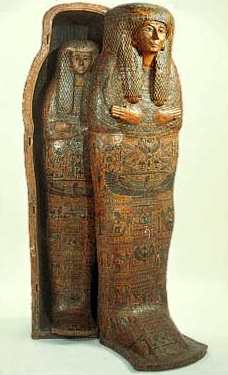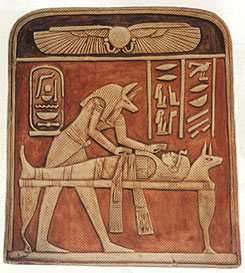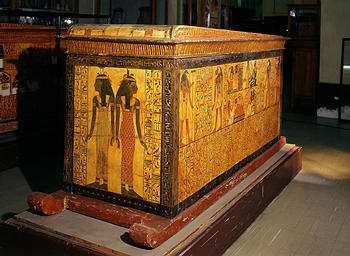» Egyptian Mummiesby Heidi Keller - January 5, 2004 |
 Mummies are such fascinating subjects. So many cultural details are involved in the process that although I wanted to focus on mummies of different countries on the same article, I thought better focus on them separately.
Mummies are such fascinating subjects. So many cultural details are involved in the process that although I wanted to focus on mummies of different countries on the same article, I thought better focus on them separately.
In this article, as the title says, you'll read about the Egyptian mummies, and
these are the aspects talked about: the history,
how they were made, the kinds of sepulchers,
the tombstones, the
religiousness that surrounded them and what
happened with them after the ancient days.
Click on the links above to be taken to these parts of the text, in case you don't want to read it all now.
History
At first, the corpses weren't mummified in Egypt. In the Pre-dynastic period (c. 3000 - 2575 BC), the bodies were put in very simple graves, which were shallow and were dug in the edge of the desert and covered in sand. Due to the dry weather, the bodies would dehydrate quickly, even before they decomposed, which made them be mummified naturally.
At a certain time in the same period, people must have noticed this process, because certain bodies must have been accidentally unburied, and thus the belief that the mummification process was important was developed.
By the end of the Pre-dynastic period, the shallow graves became sepulchers and the coffin started to be used, but in such an environment, the bodies stopped being naturally mummified by the dry sand, and the Egyptian people started to develop artificial ways to cause that mummification.
Through all the centuries in which this practice was used, the mummifiers had to struggle in developing more efficient processes that would preserve the bodies and also that would keep the mummy safe from contact with the environment, through a proper binding and settlement.
The peak of this practice was by the end of the New Kingdom period (c. 1070 BC) and in the next period, it started to decline, due to the cultural changes that happened in Egypt and as if people had finally realized how impossible this process was to accomplish perfection.
The Process
The workshops, in which the mummification process took place, were located annexed to the necropolis (which is a kind of large cemetery). In those places, the other paraphernalia that accompanied the dead was also produced, such as coffins and vases.
The methods always vary with the period and with the wealth of the dead in question and the steps in the mummification are known only through the analysis of the mummies, as no description of the process was left written.
By the end of the New Kingdom (1550-1070 BC), for example, the process used to last 70 days. First the brains were taken, then the viscera were taken through an incision made in the left side, then the viscera were cleaned, dehydrated with natron (which is a mixture of carbonate, bicarbonate, chloride and sodium sulfate), dried and were covered in a melted resin.
The body was filled with natron and perfumed resins, after this, it was left immersed in natron through around 40 days, then the materials that had been stuffed in the body were removed, and the limbs were filled with sand, clay, and other materials.
All the holes in the body were then filled with clothes soaked in resin and bags of perfumed materials like myrrh, cinnamon, and sawdust. After this, the body was unctioned with ointments, the entire surface was covered in melted resin, and then it was bind with linen, covered in jewelry and amulets, and put in the coffin.
 The organs were also kept in small vases by the sarcophagus. These were called "canopus", because the first Egyptologists used to associate them with Canopus, who was the captain of King Menelaus, who died in the Trojan War and was buried in a city of the same name, which is located in Egypt, and the Egyptians used to cult him in the form of a vase (!!).
The organs were also kept in small vases by the sarcophagus. These were called "canopus", because the first Egyptologists used to associate them with Canopus, who was the captain of King Menelaus, who died in the Trojan War and was buried in a city of the same name, which is located in Egypt, and the Egyptians used to cult him in the form of a vase (!!).
Back to the vases, they were four and each one of them kept a different organ. From the Medium
Kingdom (1070-712 BC) on, they started to have caps with the forms of heads.
The one called Imset, had a cap in the form of a man's head, represented the goddess Isis, and kept the lever.
Then there was the Hapy vase that had a cap in the form of a baboon's head, represented Nephis, the dead person's ba (soul), and kept the lungs. The other was the Duamutef, whose cap was in the form of a jackal's head, represented the goddess Neith, and kept the stomach, and last, there was the Qebehsenuf that had a cap in the form of a falcon's head, represented the goddess Selkis and kept the intestines.
The Sepulchers
After the mummies were put in the first coffin, they were sometimes put in even two others of different sizes, then inside a concrete tomb inside the sepulcher, and both were sealed. There are two kinds of coffins: those with human form that are called anthropoids, and the rectangular ones.
Depending on the period in time, sometimes the bound mummies were covered only in layers of glue and plaster and then painted, but the predominance is of the use of coffins, which could be made of wood or stone, painted or engraved.
Also, the decoration varies through time. Some coffins show the façade of a palace, others have the painting of wings on it and are covered in sacred texts and drawings of deities.
The walls of the sepulchers were painted with the dead person's life story and with the path that the dead had to follow to reach the sacred gods and be judged by them. Especially in the tombs of the most ancient periods, they were filled with food, objects of all kinds and statues that could be inhabited by the dead person's soul.
Not all the mummies were buried in pyramids, which were built only for the pharaohs and their queens and families from 2630 to 1640 BC. Vast funerary complexes surrounded the pyramids, in which there were temples as well.
There are two kinds of pyramids, the steps one, and the true pyramid. The most famous of them are those located in the Giza valley, where the pyramids of Menkaure, Chephren, and Cheops (Ancient
Kingdom - 2551-2472 BC) are placed. But there's also the steps pyramid of Djoser in Saqqara that was build in the time of the 1st dynasty (2920-2770 BC).
Another kind of sepulcher common in Egypt is the mastab. A mastab is a tomb that is rectangular with vertical walls, when they are built with bricks or inclined when they are built with stones. These were built during the Primitive Dynastic period (2920-2575 BC) and the Ancient
Kingdom (2575-2134 BC).
The second most famous funerary complex is the one called Valley Of Kings near Tebas. Some of the most important pharaohs of the New
Kingdom were buried there, like Tutmosis I and Tutankhamon. There are 62 luxurious sepulchers there, some of which were stolen and damaged. All the tombs are carved in the rock and very vast and luxurious.
The Tombstones
The tombstones and the coffins with the mummy were the most important elements of the Egyptian sepulchers. The tombstone used to have the name and the title of the dead person engraved on it, which meant to them that it "made the name live". They also had an illustration of the dead person sat at a table covered in offerings, or receiving offerings from his family members or at the presence of the gods.
This was the only external part of the tomb that used to visited by those who wanted to pray for the dead person and offerings were left in front of it. All those who would visit it had to say "hotep-di-nesu", which was a request that Osiris would give to the dead person his blessings.
The Religious Aspects
The after-life of the dead pharaoh wasn't considered like that of his subjects, neither was it considered something fixed in general. All kinds of dangers could befall the dead person's soul and the obstacles found in the after-life could only be overcome through magical ways. In this case, the pharaohs didn't have to worry much about what could happen to his soul, because he was already the "god incarnate" anyway…
The reasons behind the building of such sumptuous sepulchers, wasn't only that the rich wanted to be admired after their deaths, but also it was seen as a way for the dead to identify themselves with the gods.
Between the death and the reaching of the divine world, there was a judgment, in which the god Thot, representative of wisdom and justice, weighted the heart of the dead person. The comparison was made with the weight of Maat, which represents the perfect order.
But the texts left in the tombs and the paintings on the walls served also as a way to let the dead know ways of faking the results of the judgment to the gods, either by showing a declaration of innocence of all kinds of sins or showing the illustration of the weighting of the heart, in which the result was always shown as favorable. Smart those Egyptians… ;)
 To the Egyptians, the after-life was divided in three phases. The first was when they left life, the second the death of their existence, which had to be avoided.
To the Egyptians, the after-life was divided in three phases. The first was when they left life, the second the death of their existence, which had to be avoided.
They believed that if the judgment wasn't favorable to the dead person that he/she would go to the deepest part of the underworld where he/she would suffer the greatest punishments, and this was something to be fought, because it went against their concept of order.
If the dead person was considered light of heart, he/she would meet the great god and god of the dead Osiris and live on in the divine world or in this world as some form of ghost (or inhabiting a statue). However, if it was considered heavy of heart, the "Devouring" (a hybrid monster) would eat the dead person's soul and send it to the depths of the underworld.
The Mummies Through Time
The sepulchers have been stolen since the ancient times, and this practice still happens, although the security has been increased near the main tombs. The problem is that all kinds of unknown riches are hidden below the desert in that country, so it's impossible for the police to keep eyes on everything.
The interest on the Ancient history of Egypt started in the 15th century, when the Renascentists began to study the ancient texts that had been almost abandoned for centuries.
In the 16th century, the scholars started to pay attention to the strange monuments that still remained in Rome and that were taken from Egypt. Between this century and the next, the first visits of Europeans to Egypt started to happen. That was also when the first artifacts were taken to Europe since the times of the Romans, which made the interest on the country grow.
The hieroglyphic writing started to be studied in the 18th century, but only after the expedition of Napoleon Bonaparte found the Rosetta's Stone in 1798, on which is engraved a text in three languages, including the Egyptian and the Greek, that the study of the language developed, with the help specially of Jean-François Champollion le Jeune. This discovery was crucial for the understanding of all the Egyptian texts, but there are some that are still undecipherable.
The first important discovery of mummies happened in 1870, when the mummies of almost all the pharaohs of the New
Kingdom were found in the Valley Of Kings. Then in 1922, Howard Carter found the mummy of Tutankhamon in the same region, which started a fashion in Europe and America of Egyptian-looking objects and clothes.
Recently a nomad's mule found a tomb in the middle of the desert of the Greco-Roman period. After the Egyptologists analyzed it, they found that it was a large underground funerary crypt filled with mummies covered in priceless gold masks, and new discoveries are still being made in it.
It seems that Egypt will continue to yield novelties to the world and the story of the mummies is far from being closed…
If you want more information:
Encyclopedia Smithsonian Egyptian Mummies
*This work's rights belong to the author. No reproduction allowed without the author's consent. If you want to link to this article from your site, please read our privacy policy about it. Thank you!*
::: home ::: darklore section :::
Copyright © 2004 Heidi Keller